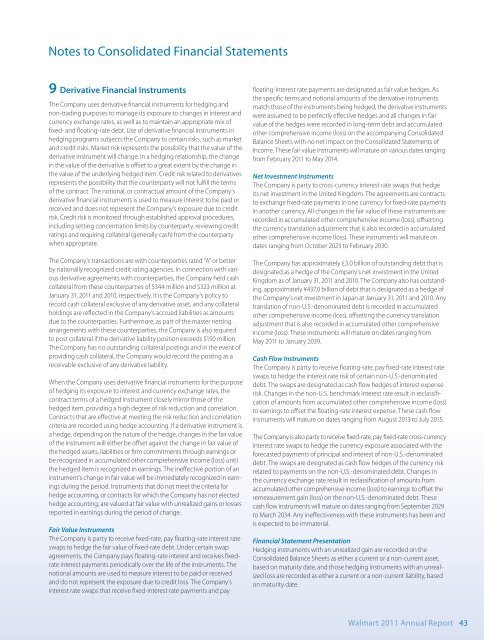Management's Discussion and Analysis of Financial ... - Wal-Mart
Management's Discussion and Analysis of Financial ... - Wal-Mart
Management's Discussion and Analysis of Financial ... - Wal-Mart
- No tags were found...
Create successful ePaper yourself
Turn your PDF publications into a flip-book with our unique Google optimized e-Paper software.
Notes to Consolidated <strong>Financial</strong> Statements9 Derivative <strong>Financial</strong> InstrumentsThe Company uses derivative financial instruments for hedging <strong>and</strong>non-trading purposes to manage its exposure to changes in interest <strong>and</strong>currency exchange rates, as well as to maintain an appropriate mix <strong>of</strong>fixed- <strong>and</strong> floating-rate debt. Use <strong>of</strong> derivative financial instruments inhedging programs subjects the Company to certain risks, such as market<strong>and</strong> credit risks. Market risk represents the possibility that the value <strong>of</strong> thederivative instrument will change. In a hedging relationship, the changein the value <strong>of</strong> the derivative is <strong>of</strong>fset to a great extent by the change inthe value <strong>of</strong> the underlying hedged item. Credit risk related to derivativesrepresents the possibility that the counterparty will not fulfill the terms<strong>of</strong> the contract. The notional, or contractual amount <strong>of</strong> the Company’sderivative financial instruments is used to measure interest to be paid orreceived <strong>and</strong> does not represent the Company’s exposure due to creditrisk. Credit risk is monitored through established approval procedures,including setting concentration limits by counterparty, reviewing creditratings <strong>and</strong> requiring collateral (generally cash) from the counterpartywhen appropriate.The Company’s transactions are with counterparties rated “A” or betterby nationally recognized credit rating agencies. In connection with variousderivative agreements with counterparties, the Company held cashcollateral from these counterparties <strong>of</strong> $344 million <strong>and</strong> $323 million atJanuary 31, 2011 <strong>and</strong> 2010, respectively. It is the Company’s policy torecord cash collateral exclusive <strong>of</strong> any derivative asset, <strong>and</strong> any collateralholdings are reflected in the Company’s accrued liabilities as amountsdue to the counterparties. Furthermore, as part <strong>of</strong> the master nettingarrangements with these counterparties, the Company is also requiredto post collateral if the derivative liability position exceeds $150 million.The Company has no outst<strong>and</strong>ing collateral postings <strong>and</strong> in the event <strong>of</strong>providing cash collateral, the Company would record the posting as areceivable exclusive <strong>of</strong> any derivative liability.When the Company uses derivative financial instruments for the purpose<strong>of</strong> hedging its exposure to interest <strong>and</strong> currency exchange rates, thecontract terms <strong>of</strong> a hedged instrument closely mirror those <strong>of</strong> thehedged item, providing a high degree <strong>of</strong> risk reduction <strong>and</strong> correlation.Contracts that are effective at meeting the risk reduction <strong>and</strong> correlationcriteria are recorded using hedge accounting. If a derivative instrument isa hedge, depending on the nature <strong>of</strong> the hedge, changes in the fair value<strong>of</strong> the instrument will either be <strong>of</strong>fset against the change in fair value <strong>of</strong>the hedged assets, liabilities or firm commitments through earnings orbe recognized in accumulated other comprehensive income (loss) untilthe hedged item is recognized in earnings. The ineffective portion <strong>of</strong> aninstrument’s change in fair value will be immediately recognized in earningsduring the period. Instruments that do not meet the criteria forhedge accounting, or contracts for which the Company has not electedhedge accounting, are valued at fair value with unrealized gains or lossesreported in earnings during the period <strong>of</strong> change.Fair Value InstrumentsThe Company is party to receive fixed-rate, pay floating-rate interest rateswaps to hedge the fair value <strong>of</strong> fixed-rate debt. Under certain swapagreements, the Company pays floating-rate interest <strong>and</strong> receives fixedrateinterest payments periodically over the life <strong>of</strong> the instruments. Thenotional amounts are used to measure interest to be paid or received<strong>and</strong> do not represent the exposure due to credit loss. The Company’sinterest rate swaps that receive fixed-interest rate payments <strong>and</strong> payfloating-interest rate payments are designated as fair value hedges. Asthe specific terms <strong>and</strong> notional amounts <strong>of</strong> the derivative instrumentsmatch those <strong>of</strong> the instruments being hedged, the derivative instrumentswere assumed to be perfectly effective hedges <strong>and</strong> all changes in fairvalue <strong>of</strong> the hedges were recorded in long-term debt <strong>and</strong> accumulatedother comprehensive income (loss) on the accompanying ConsolidatedBalance Sheets with no net impact on the Consolidated Statements <strong>of</strong>Income. These fair value instruments will mature on various dates rangingfrom February 2011 to May 2014.Net Investment InstrumentsThe Company is party to cross-currency interest rate swaps that hedgeits net investment in the United Kingdom. The agreements are contractsto exchange fixed-rate payments in one currency for fixed-rate paymentsin another currency. All changes in the fair value <strong>of</strong> these instruments arerecorded in accumulated other comprehensive income (loss), <strong>of</strong>fsettingthe currency translation adjustment that is also recorded in accumulatedother comprehensive income (loss). These instruments will mature ondates ranging from October 2023 to February 2030.The Company has approximately £3.0 billion <strong>of</strong> outst<strong>and</strong>ing debt that isdesignated as a hedge <strong>of</strong> the Company’s net investment in the UnitedKingdom as <strong>of</strong> January 31, 2011 <strong>and</strong> 2010. The Company also has outst<strong>and</strong>ing,approximately ¥437.0 billion <strong>of</strong> debt that is designated as a hedge <strong>of</strong>the Company’s net investment in Japan at January 31, 2011 <strong>and</strong> 2010. Anytranslation <strong>of</strong> non-U.S.-denominated debt is recorded in accumulatedother comprehensive income (loss), <strong>of</strong>fsetting the currency translationadjustment that is also recorded in accumulated other comprehensiveincome (loss). These instruments will mature on dates ranging fromMay 2011 to January 2039.Cash Flow InstrumentsThe Company is party to receive floating-rate, pay fixed-rate interest rateswaps to hedge the interest rate risk <strong>of</strong> certain non-U.S.-denominateddebt. The swaps are designated as cash flow hedges <strong>of</strong> interest expenserisk. Changes in the non-U.S. benchmark interest rate result in reclassification<strong>of</strong> amounts from accumulated other comprehensive income (loss)to earnings to <strong>of</strong>fset the floating-rate interest expense. These cash flowinstruments will mature on dates ranging from August 2013 to July 2015.The Company is also party to receive fixed-rate, pay fixed-rate cross-currencyinterest rate swaps to hedge the currency exposure associated with theforecasted payments <strong>of</strong> principal <strong>and</strong> interest <strong>of</strong> non-U.S.-denominateddebt. The swaps are designated as cash flow hedges <strong>of</strong> the currency riskrelated to payments on the non-U.S.-denominated debt. Changes inthe currency exchange rate result in reclassification <strong>of</strong> amounts fromaccumulated other comprehensive income (loss) to earnings to <strong>of</strong>fset theremeasurement gain (loss) on the non-U.S.-denominated debt. Thesecash flow instruments will mature on dates ranging from September 2029to March 2034. Any ineffectiveness with these instruments has been <strong>and</strong>is expected to be immaterial.<strong>Financial</strong> Statement PresentationHedging instruments with an unrealized gain are recorded on theConsolidated Balance Sheets as either a current or a non-current asset,based on maturity date, <strong>and</strong> those hedging instruments with an unrealizedloss are recorded as either a current or a non-current liability, basedon maturity date.<strong>Wal</strong>mart 2011 Annual Report 43





